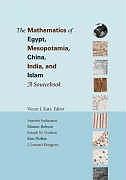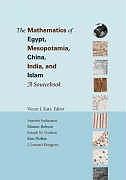The Mathematics of Egypt, Mesopotamia, China, India, and Islam
Einband:
Fester Einband
EAN:
9780691114859
Untertitel:
A Sourcebook
Autor:
Victor J. Katz
Herausgeber:
Princeton University Press
Anzahl Seiten:
702
Erscheinungsdatum:
05.08.2007
ISBN:
0691114854
Provides a collection of English translations of mathematical texts from five important ancient and medieval non-Western mathematical cultures, and puts them into historical and mathematical context. This book is intended for mathematics teachers who want to use non-Western mathematical ideas in the classroom.
"[This] is the biggest sourcebook containing the newest fruit of historical research and that is why the book can replace older sources for the history of mathematics."
Autorentext
Victor J. Katz is professor emeritus of mathematics at the University of the District of Columbia. His many books include the textbook, A History of Mathematics: An Introduction, 2nd ed. (Addison-Wesley). He is the coeditor of Historical Modules for the Teaching and Learning of Mathematics.
Klappentext
In recent decades it has become obvious that mathematics has always been a worldwide activity. But this is the first book to provide a substantial collection of English translations of key mathematical texts from the five most important ancient and medieval non-Western mathematical cultures, and to put them into full historical and mathematical context. The Mathematics of Egypt, Mesopotamia, China, India, and Islam gives English readers a firsthand understanding and appreciation of these cultures' important contributions to world mathematics. The five section authors-Annette Imhausen (Egypt), Eleanor Robson (Mesopotamia), Joseph Dauben (China), Kim Plofker (India), and J. Lennart Berggren (Islam)-are experts in their fields. Each author has selected key texts and in many cases provided new translations. The authors have also written substantial section introductions that give an overview of each mathematical culture and explanatory notes that put each selection into context. This authoritative commentary allows readers to understand the sometimes unfamiliar mathematics of these civilizations and the purpose and significance of each text. Addressing a critical gap in the mathematics literature in English, this book is an essential resource for anyone with at least an undergraduate degree in mathematics who wants to learn about non-Western mathematical developments and how they helped shape and enrich world mathematics. The book is also an indispensable guide for mathematics teachers who want to use non-Western mathematical ideas in the classroom.
Inhalt
Preface ix Permissions xi Introduction 1 Chapter 1: Egyptian Mathematics Annette Imhausen Preliminary Remarks 7 I. Introduction 9 a. Invention of writing and number systems 13 b. Arithmetic 14 c.Metrology 17 II. Hieratic Mathematical Texts 17 a. Table texts 18 b. Problem texts 24 III. Mathematics in Administrative Texts 40 a. Middle Kingdom texts: The Reisner papyri 40 b. New Kingdom texts: Ostraca from Deir el Medina 44 IV. Mathematics in the Graeco-Roman Period 46 a. Context 46 b. Table texts 47 c. Problem texts 48 V. Appendices 52 a. Glossary of Egyptian terms 52 b. Sources 52 c. References 54 Chapter 2: Mesopotamian Mathematics Eleanor Robson I. Introduction 58 a. Mesopotamian mathematics through Western eyes 58 b.Mathematics and scribal culture in ancient Iraq 62 c. From tablet to translation 65 d. Explananda 68 II. The Long Third Millennium, c. 3200-2000 BCE 73 a. Uruk in the late fourth millennium 73 b. Shuruppag in the mid-third millennium 74 c. Nippur and Girsu in the twenty-fourth century BCE 76 d. Umma and Girsu in the twenty-first century BCE 78 III. The Old Babylonian Period, c. 2000-1600 BCE 82 a. Arithmetical and metrological tables 82 b. Mathematical problems 92 c. Rough work and reference lists 142 IV. Later Mesopotamia, c. 1400-150 BCE 154 V. Appendices 180 a. Sources 180 b. References 181 Chapter 3: Chinese Mathematics Joseph W. Dauben Preliminary Remarks 187 I. China: The Historical and Social Context 187 II. Methods and Procedures: Counting Rods, The "Out-In" Principle 194 III. Recent Archaeological Discoveries: The Earliest Yet-Known Bamboo Text 201 IV. Mathematics and Astronomy: The Zhou bi suan jing and Right Triangles (The Gou-gu or "Pythagorean" Theorem) 213 V. The Chinese "Euclid", Liu Hui 226 a. The Nine Chapters 227 b. The Sea Island Mathematical Classic 288 VI. The "Ten Classics" of Ancient Chinese Mathematics 293 a. Numbers and arithmetic: The Mathematical Classic of Master Sun 295 b. The Mathematical Classic of Zhang Qiujian 302 VII. Outstanding Achievements of the Song and Yuan Dynasties (960-1368 CE) 308 a. Qin Jiushao 309 b. Li Zhi (Li Ye) 323 c. Yang Hui 329 d. Zhu Shijie 343 VIII. Matteo Ricci and Xu Guangxi, "Prefaces" to the First Chinese Edition of Euclid's Elements (1607) 366 IX. Conclusion 375 X. Appendices 379 a. Sources 379 b. Bibliographic guides 379 c. References 380 Chapter 4: Mathematics in India Kim Plofker I. Introduction: Origins of Indian Mathematics 385 II. Mathematical Texts in Ancient India 386 a. The Vedas 386 b. The Si ulbasutras 387 c. Mathematics in other ancient texts 393 d. Number systems and numerals 395 III. Evolution of Mathematics in Medieval India 398 a.Mathematics chapters in Siddhanta texts 398 b. Transmission of mathematical ideas to the Islamic world 434 c. Textbooks on mathematics as a separate subject 435 d. The audience for mathematics education 477 e. Specialized mathematics: Astronomical and cosmological problems 478 IV. The Kerala School 480 a. Madhava, his work, and his school 480 b. Infinite series and the role of demonstrations 481 c. Other mathematical interests in the Kerala school 493 V. Continuity and Transition in the Second Millennium 498 a. The ongoing development of Sanskrit mathematics 498 b. Scientific exchanges at the courts of Delhi and Jaipur 504 c. Assimilation of ideas from Islam; mathematical table texts 506 VI. Encounters with Modern Western Mathematics 507 a. Early exchanges with European mathematics 507 b. European versus "native" mathematics education in British India 508 c. Assimilation into modern global mathematics 510 VII. Appendices 511 a. Sources 511 b. References 512 Chapter 5: Mathematics in Medieval Islam J. Lennart Berggren I. Introduction 515 II. Appropriation of the Ancient Heritage 520 III. Arithmetic 525 IV. Algebra 542 V. Number Theory 560 VI. Geometry 564 a. Theoretical geometry 564 b. Practical geometry 610 VII. Trigonometry 621 VIII. Combinatorics 658 IX. On mathematics 666 X. Appendices 671 a. Sources 671 b. References 674 Contributors 677 Index 681

Leider konnten wir für diesen Artikel keine Preise ermitteln ...
billigbuch.ch sucht jetzt für Sie die besten Angebote ...
Die aktuellen Verkaufspreise von 6 Onlineshops werden in Realtime abgefragt.
Sie können das gewünschte Produkt anschliessend direkt beim Anbieter Ihrer Wahl bestellen.
Loading...
Die aktuellen Verkaufspreise von 6 Onlineshops werden in Realtime abgefragt.
Sie können das gewünschte Produkt anschliessend direkt beim Anbieter Ihrer Wahl bestellen.
| # | Onlineshop | Preis CHF | Versand CHF | Total CHF | ||
|---|---|---|---|---|---|---|
| 1 | Seller | 0.00 | 0.00 | 0.00 |
